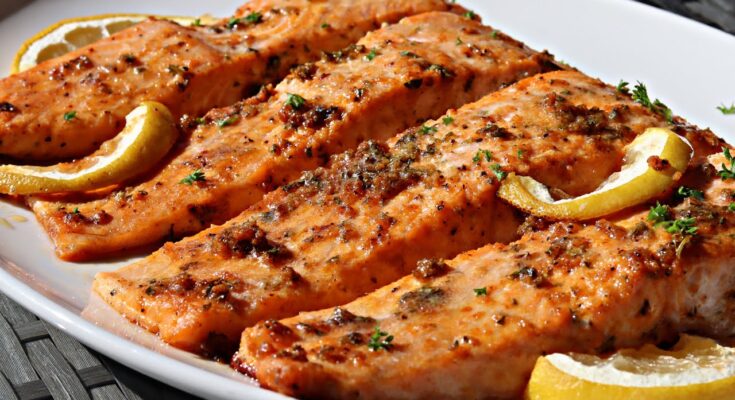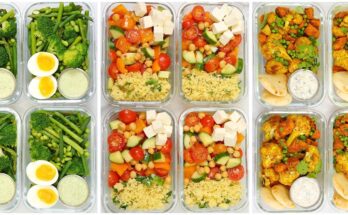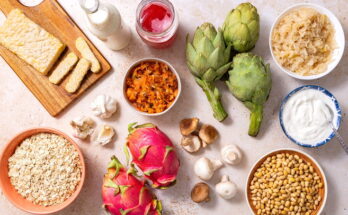Best Baked Salmon Recipe: Salmon is one of those magical proteins that feels fancy but is unbelievably simple to prepare. Whether you’re cooking for a weeknight dinner or a special occasion, this baked salmon recipe is your go-to option. Not only is it bursting with flavor, but it’s also packed with Omega-3 fatty acids, essential nutrients, and lean protein, making it a heart-healthy favorite for everyone in the family.
Baking salmon ensures you get a perfectly moist, flaky texture without needing a grill or a stovetop. It’s a hands-off, low-effort way to serve a gourmet meal right from your oven. Plus, you can play around with flavors—lemon, garlic, herbs, spices—to match your cravings.
This step-by-step guide will walk you through the entire process, from picking the best salmon to serving it like a pro. So, let’s dive into the ultimate baked salmon recipe that’s easy, quick, and irresistibly delicious.
Ingredients You’ll Need
Before diving into the oven magic, let’s gather what you need to create this show-stopping dish. You don’t need a pantry full of gourmet items—just a handful of simple, fresh ingredients.
Essential Ingredients:
- 4 salmon fillets (6 oz each), preferably skin-on
- 2 tablespoons olive oil
- 2 cloves garlic, minced
- 1 lemon (juice and zest)
- Salt and black pepper, to taste
- Fresh herbs like dill, parsley, or thyme
Optional Ingredients for Extra Flavor:
- 1 tablespoon Dijon mustard
- 1 tablespoon honey or maple syrup (for a sweet glaze)
- Paprika or red pepper flakes (for a little kick)
- Sliced onion, tomatoes, or bell peppers for roasting alongside
Pantry Staples:
- Aluminum foil or parchment paper (for easy cleanup)
- Baking sheet or a glass casserole dish
The beauty of this recipe is in its flexibility. Want something tangy? Add mustard and lemon. Feeling indulgent? A touch of butter and honey makes it rich. It’s all up to your taste buds.
Choosing the Right Salmon
Not all salmon is created equal. When it comes to getting the most flavor and nutritional value, choosing the right type of salmon is key.
Wild-Caught vs. Farm-Raised:
Wild-caught salmon typically has a deeper, richer flavor and a firmer texture. It’s also generally leaner and contains fewer contaminants. On the other hand, farm-raised salmon is often more affordable and has a higher fat content, which can make it juicier and softer when baked. Both options work, but wild-caught is often the top pick for flavor and health.
Tips for Selecting Fresh Salmon:
- Look for vibrant, pink-orange flesh with no grayish spots
- Avoid fillets with a fishy smell; fresh salmon should smell like the ocean
- Press the flesh gently—it should bounce back, not leave a dent
- Choose skin-on fillets if possible, as the skin helps retain moisture
If you’re buying frozen salmon, no worries—just thaw it overnight in the fridge for best results. And always pat it dry before seasoning to avoid a soggy bake.
Preparing the Salmon for Baking
This part might feel intimidating, but it’s surprisingly simple. Prepping your salmon correctly ensures a flawless cook every time.
Step-by-Step Prep:
- Thaw if needed: If your salmon is frozen, let it thaw fully in the refrigerator overnight.
- Rinse and dry: Gently rinse the fillets under cold water and pat them dry with paper towels. Moisture is your enemy when you want crispy skin or a good sear.
- Remove pin bones: Run your fingers over the flesh to feel for tiny bones. Use kitchen tweezers to pull them out gently.
- Let it rest: Let the salmon sit out for 10-15 minutes to reach room temperature. This promotes even cooking.
A little care here goes a long way. And remember, always place the salmon skin-side down on your baking sheet—it acts as a barrier to keep the fish juicy and flavorful.
Best Marinades and Seasonings
Now we’re talking flavor. While salmon is delicious on its own, the right marinade or seasoning blend can take it to the next level. Here are a few go-to combos that never fail:
1. Classic Garlic Lemon Herb:
- 2 tablespoons olive oil
- Juice of 1 lemon
- 2 cloves garlic, minced
- 1 tablespoon chopped fresh dill or parsley
- Salt and pepper to taste
2. Sweet Honey Mustard Glaze:
- 1 tablespoon Dijon mustard
- 1 tablespoon honey or maple syrup
- 1 teaspoon soy sauce
- 1/2 teaspoon black pepper
3. Spicy Cajun Rub:
- 1 tablespoon olive oil
- 1 teaspoon Cajun seasoning
- 1/2 teaspoon paprika
- A pinch of cayenne pepper
- Fresh lemon wedges for serving
Just whisk together your chosen marinade, pour it over the salmon, and let it sit for 10-20 minutes. You can also marinate in a ziplock bag or shallow dish. For rubs, just coat the fillets evenly and bake right away.
How to Bake Salmon to Perfection
Baking salmon is incredibly easy, but a few expert tips can make the difference between a dry fillet and a juicy masterpiece. Here’s how to do it the right way every time.
Step-by-Step Baking Instructions:
- Preheat your oven to 375°F (190°C). This is the sweet spot where salmon cooks through evenly without drying out.
- Line a baking sheet with parchment paper or foil. This makes cleanup a breeze and prevents sticking.
- Place the salmon fillets skin-side down on the sheet. Give them a little space to allow air circulation for even baking.
- Brush with marinade or oil to help seal in moisture. Add your seasoning blend or sauce of choice.
- Bake for 12 to 15 minutes, depending on the thickness of your fillet. A good rule of thumb is 4-6 minutes per ½ inch of thickness.
- Check for doneness. The salmon should flake easily with a fork and be opaque throughout. If you’re using a meat thermometer, aim for 125°F for medium-rare or 140°F for fully cooked.
Avoid overbaking—nothing ruins a good piece of salmon faster. Remember, it continues cooking slightly after you remove it from the oven, so pull it out just as it turns opaque and flaky.
Serving Suggestions and Side Dishes
Now that your salmon is perfectly baked, it’s time to plate it up! The beauty of baked salmon is its versatility—it pairs well with just about anything. Whether you’re going for low-carb, hearty, or comfort food vibes, there’s a side that suits your meal.
Top Side Dish Options:
- Roasted Vegetables: Toss asparagus, broccoli, or carrots in olive oil, salt, and pepper, and roast them alongside your salmon.
- Garlic Mashed Potatoes: Creamy and rich, these add a comforting touch to your plate.
- Steamed Rice or Quinoa: Perfect for soaking up any extra sauce or marinade.
- Fresh Salad: A crisp, lemony arugula or spinach salad balances the richness of the salmon beautifully.
- Pasta with Pesto: Adds a burst of herby flavor that complements the fish well.
You can also flake the baked salmon over a salad, mix it into a pasta dish, or even use it in tacos. The options are endless and delicious every time.
Tips for Leftovers and Storage
Let’s be real—leftover salmon is a blessing in disguise. If you’ve made a big batch, don’t worry. Baked salmon stores well and can be repurposed in creative ways.
Storing Leftovers:
- Let salmon cool completely before storing.
- Place in an airtight container and refrigerate for up to 3 days.
- Reheat gently in a microwave or oven (300°F for 10 minutes) to avoid drying it out.
Creative Leftover Ideas:
- Salmon Salad: Flake the leftovers and mix with Greek yogurt, mustard, celery, and herbs for a protein-packed lunch.
- Salmon Patties: Combine with breadcrumbs, egg, and seasoning, then pan-fry into golden cakes.
- Breakfast Bowl: Toss salmon with scrambled eggs, spinach, and avocado for a hearty morning meal.
Don’t toss those extras—turn them into another meal you’ll look forward to!
Common Mistakes to Avoid When Baking Salmon
Even seasoned cooks can slip up with salmon. Here are some rookie mistakes you’ll want to dodge:
- Overcooking: This is the biggest culprit. Keep a close eye and use a timer.
- Skipping the drying step: Moisture on the fillets can prevent that nice, caramelized crust.
- Crowding the pan: This leads to uneven cooking. Give each fillet breathing room.
- Not using enough seasoning: Salmon has a strong flavor, yes, but it still needs a good dose of seasoning to shine.
- Forgetting to rest the fish: Letting it sit for a couple of minutes after baking helps redistribute juices.
Avoid these, and you’ll be serving up restaurant-quality salmon every time.
FAQs about Best Baked Salmon Recipe
1. What is the best temperature to bake salmon?
The ideal temperature to bake salmon is 375°F (190°C). This allows the fish to cook evenly while staying juicy and tender inside with a beautifully flaky texture.
2. How long should I bake salmon in the oven?
Bake salmon for about 12-15 minutes depending on the thickness. A good rule of thumb is 4-6 minutes per half-inch of thickness. You’ll know it’s ready when it flakes easily with a fork.
3. Should I cover salmon when baking?
You don’t need to cover it, but for extra moistness, you can wrap it in foil. This locks in steam and keeps the salmon buttery soft—perfect for flavor-infused bakes with herbs, lemon, or garlic.
4. What seasoning is best for baked salmon?
Classic seasonings like garlic, lemon, dill, black pepper, and olive oil are go-to favorites. For a bolder twist, try a honey mustard glaze or a Cajun rub.
5. Can I bake frozen salmon?
Yes, you can bake frozen salmon straight from the freezer—just add an extra 5-10 minutes to the cooking time. However, thawing it first helps with even seasoning and texture.
6. How do I know when salmon is fully cooked?
Use a fork to check for flakiness or a thermometer for precision. Salmon is cooked when the internal temp hits 145°F (63°C). The center should be opaque and slightly pink.
7. Is baked salmon healthy?
Absolutely! Salmon is rich in omega-3 fatty acids, high-quality protein, and essential vitamins. Baking uses less oil, making it one of the healthiest cooking methods.
8. What sides go best with baked salmon?
Popular sides include roasted veggies, garlic mashed potatoes, quinoa, or a fresh green salad. Light and zesty complements balance the rich, savory salmon flavor.
Conclusion
There you have it—the ultimate baked salmon recipe that’s simple, flavorful, and versatile. Whether you’re cooking for a quick dinner or entertaining guests, this recipe never fails to impress. With the right ingredients, proper prep, and a touch of creativity, you can make baked salmon the star of your table.
This isn’t just food—it’s a whole vibe. Light, healthy, rich in flavor, and totally customizable. So the next time you’re wondering what to cook that’s fast and fabulous, let this baked salmon guide be your answer.



